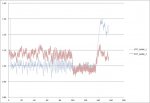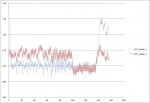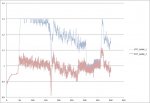Here is a chart showing just the STFT values. At first is a period of idle while waiting for temp to get up around 170*, then a few seconds of 1500 rpms, then 2500 rpms followed by returning to idle.

Note how the values "snap" to what appears they should be in the 2500 rpm range between 100 seconds and 135 seconds. Also note the big difference in the early idle values and the ending idle values.
It would be interesting to do a slow rpm 'sweep' (idle-3,500-idle) and see how the STFT's react. I know when I did so in Open Loop, the MAF tuning was remarkably steady with a Lambda value of 0.99-1.01.
If I average the values in the 2500 rpm section, the average Bank 1 STFT = 0.99 while the average of the Bank 2 STFT = 0.98 which is really about the best one could hope for. If I could get results like that across the entire rpm range, I would be extremely pleased.



